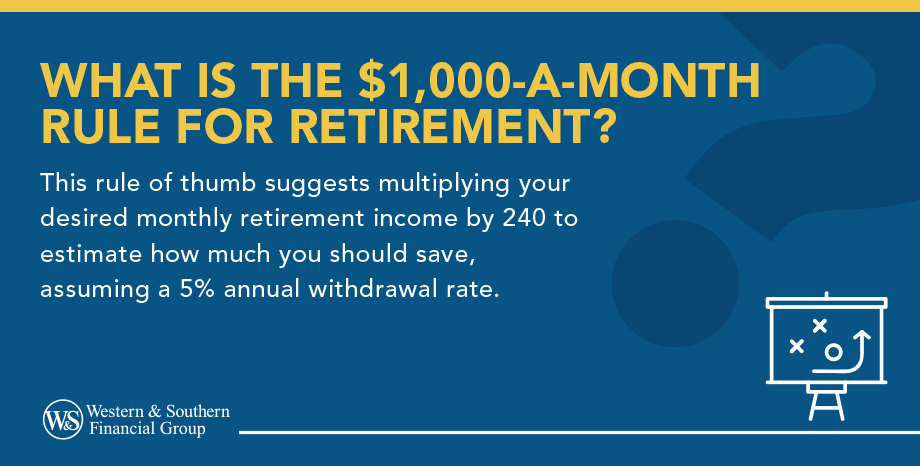

Key Takeaways
- The $1,000-a-month rule says you’ll need $240,000 in savings for every $1,000 monthly retirement income you want.
- This rule uses a 5% annual withdrawal rate and assumes your savings stay invested to grow with inflation.
- It’s a simple way to set retirement goals, but it doesn’t include Social Security, taxes, or market ups and downs.
- Other planning methods, like the 4% but or 25X rule, may be more cautious and consider long-term risks.
- The $1,000 rule can be a starting point, but it works best as part of a bigger retirement strategy tailored to your needs.
Understanding the $1,000-A-Month Rule
If you're trying to estimate how much you need for life during retirement, you've likely come across the $1,000-a-month rule. It's a common rule of thumb that helps simplify retirement planning, especially for people looking for a straightforward savings target.
The $1,000-a-month savings retirement rule suggests that for every $1,000 of monthly retirement income you want, you'll need about $240,000 in your retirement fund.1 This estimate is based on an annual withdrawal rate of 5% and assumes your savings will be invested in a mix of assets that keep pace with inflation and generate returns.2
This rule gained popularity because of its simplicity. It offers a quick way to set a rough retirement goal based on how much you think you'll need each month in retirement.
How the $1,000 Rule Works in Practice
While the rule provides a clean benchmark, the real-life application requires understanding the math and the assumptions behind it. Let's break it down.
Applying Math to Real-Life Scenarios
To apply the $1,000-a-month rule, multiply your desired monthly income by 240. Here's how it unfolds:
- $1,000/month = $240,000 in savings
- $2,000/month = $480,000 in savings
- $3,000/month = $720,000 in savings
- $4,000/month = $960,000 in savings
This doesn't include Social Security, monthly retirement benefits, or other sources of income, so it's a conservative approach. You should save less if you expect monthly retirement income from a pension or annuity.
Factors That Affect the Rule's Accuracy
There are several reasons why the $1,000 rule may not work for everyone:
- Inflation: As the cost of living increases over time, your retirement expenses can rise, potentially reducing the purchasing power of your savings.
- Investment Returns: The stock market's ups and downs can significantly impact the longevity of your retirement savings.
- Taxes: Withdrawals from traditional retirement accounts, such as 401(k)s, are typically subject to taxation. Tax rules vary by account type and income level.
- Retirement Age: The earlier you choose to retire, the longer your savings must last to support your living expenses.
- Spending Needs: Your financial needs can fluctuate as your monthly expenses increase or decrease throughout retirement.
Understanding these factors can help you better adjust the $1,000-a-month rule to fit your unique retirement needs and goals.
Pros & Cons of Using the $1,000-a-Month Rule
The $1,000-a-month rule is easy to use, but like most shortcuts, it has limitations. Here's a breakdown of the pros and cons.
Advantages of Using the Rule
- Easy to Understand and Use: This rule offers a quick mental shortcut for setting savings targets—no spreadsheets or complex math required.
- Clear, Trackable Goals: It gives you a tangible savings target that can help keep you motivated and make it easier to measure your progress over time.
- Scalable: Can be easily adjusted up or down based on your desired monthly retirement income needs.
- Helps with Budgeting: Connects your savings habits with tangible future income results.
Drawbacks and Limitations
- Too Simplified: Does not consider changes in spending habits during retirement or additional income sources that may become available.
- Ignores Social Security: Many retirees depend extensively on the monthly benefits they receive during retirement.
- Static Assumptions: It assumes a fixed 5% withdrawal rate and does not take into account individual circumstances or financial nuances.
- Doesn't account for Inflation: Future dollars will have less purchasing power than today's.
- Market Volatility Risk: The 5% withdrawal rate may not be sustainable during severe market downturns.
- Tax Implications Overlooked: It doesn’t reflect how different retirement accounts are taxed, potentially overestimating actual income.
- Longevity Concerns: Doesn't adjust for varying life expectancies or the possibility of outliving your savings.
While the $1,000-a-month rule offers a helpful starting point for retirement planning, it's best used in conjunction with more comprehensive financial strategies that address its limitations and adapt to your unique circumstances.
Compared to Other Retirement Planning Guidelines
To help determine if the $1,000 rule fits your needs, let's examine how the $1,000-a-month savings retirement rule compares to other widely recognized financial benchmarks and rules of thumb.
The 4% Rule
The 4% rule suggests withdrawing 4% of your portfolio annually to avoid running out of money over 30 years.3 That would mean you need $300,000 to generate $1,000/month, assuming no other sources of income.
The 4% rule is more conservative than the $1,000-a-month rule. Financial professionals who want to factor in market risk and annual expenses often prefer it. This method is also used as a baseline rate for sustainable withdrawal strategies.
Replacement Ratio Method
The replacement ratio method recommends replacing 70% to 80% of your pre-retirement income.4 If you earned $60,000 annually, you'd aim for $42,000 to $48,000 annually in income during retirement.
This approach can be more comprehensive since it accounts for lifestyle, taxes, and retirement expenses, but requires more customization than other rules of thumb.
The 25X Rule
The 25X rule suggests saving 25 times your annual expenses before retiring.5 For example, if you need $40,000 yearly in retirement, your target would be $1 million in savings.
This rule aligns with the 4% withdrawal strategy but frames it differently, focusing on the total sum rather than withdrawal rates. It offers another practical benchmark for savers.
The 15% Savings Rule
Financial experts often recommend saving 15% of your gross income for retirement throughout your working years.6 This guideline reflects an ideal annual savings rate and emphasizes consistent contributions.
Unlike the $1,000-a-month rule, this method doesn't clarify your expected retirement income, but it offers a dependable financial strategy that prioritizes long-term growth.
The 110-Minus-Age Rule
This guideline helps determine asset allocation by suggesting you subtract your age from 110 to find the percentage of your portfolio that should be in stocks.7 For instance, a 40-year-old would aim for 70% stocks and 30% bonds.
While the $1,000-a-month rule focuses on the amount needed, this rule addresses how to invest those funds based on your risk tolerance, time horizon, and comfort with market fluctuations.
Different retirement planning methods have unique pros and cons. Using a mix of approaches that suit your financial situation, goals, and risk is crucial.
How to Use This Rule as Part of a Bigger Plan
While the $1,000 rule is helpful, it should be just one of your overall strategies. Use it to frame your savings goals, then dig deeper. Here are ways to get you started:
- Calculate your projected monthly expenses, including housing, healthcare, travel, and any other relevant costs, such as inflation. Be sure to account for potential taxes and changes in spending habits over time.
- Deduct any guaranteed sources of monthly income, such as Social Security benefits or pension payments.
- Determine the shortfall, which indicates the amount you need to save.
- Use a retirement calculator to explore how changes in retirement age, investment returns, or income needs impact your savings target. Consider how market uncertainty might affect those projections.
- Talk to a licensed financial professional to explore strategies that consider taxes, risk tolerance, and income flexibility.
Reviewing your annual savings rate can help keep your plan on track as market conditions shift. Tracking monthly retirement benefits and other income sources makes building a realistic picture of your life during retirement easier.
Final Thoughts
The $1,000-a-month rule is a great entry point for thinking about your future, but it's not the final word. Use it to guide your savings strategy, then refine your plan with real numbers. If you're ready to turn your estimate into a complete plan, talk to a professional to take the next step.
Start your $1,000-a-month rule today to help ensure a comfortable future. Calculate Savings
Frequently Asked Questions
Is the $1,000-a-month rule reliable for retirement planning?
Does the $1,000-a-month rule account for inflation?
Does the $1,000-a-month rule include Social Security benefits?
When should I start saving for retirement using the $1,000-a-month rule?
Should I use multiple retirement planning methods besides the $1,000 rule?
Sources & Footnotes
- What Is the $1,000 a Month Rule for Retirement Planning? https://finance.yahoo.com/news/1-000-month-rule-retirement-003941146.html.
- These rules are general in nature and may not suit every individual's financial situation. Consult a financial professional for guidance tailored to your personal goals.
- It’s time to rethink how to make your money last in retirement. https://www.cnn.com/2024/11/25/business/retirement-4-percent-rule/index.html.
- The Replacement Ratio Method: How Much Income Do You Really Need in Retirement? https://blog.bradpine.com/2023/10/13/the-replacement-ratio-method-how-much-income-do-you-really-need-in-retirement/.
- 25x Retirement Rule: How to Calculate and Examples. https://smartasset.com/retirement/25x-retirement-rule.
- Reasons why you should aim to save 15% for retirement. https://www.troweprice.com/personal-investing/resources/insights/save-15-percent-for-retirement.html.
- What Is the Rule of 110? https://www.fool.com/terms/r/rule-of-110/.






